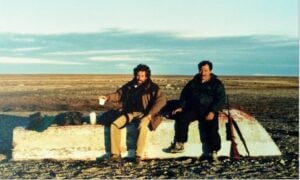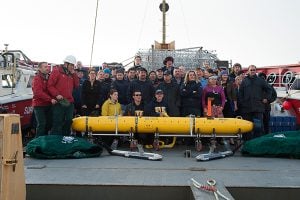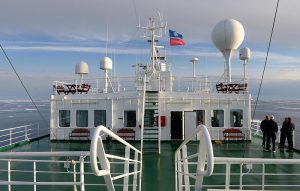
History
2014 Victoria Strait Expedition
This year's search is about much more than underwater archaeology. The Victoria Strait Expedition will contribute to northern science and communities.
- 1205 words
- 5 minutes
This article is over 5 years old and may contain outdated information.
History

IN AN AGE AND A CULTURE OBSESSED with crime scene investigations, the almost 170-year-old mystery surrounding the fate of Sir John Franklin’s expedition to find the Northwest Passage comes furnished with all the elements: cryptic notes hidden in stone cairns, suggestive clues scattered haphazardly across a forbidding landscape and crew members’ bones bearing evidence of both severe lead poisoning and the cannibalism that would scandalize Victorian England. Eyewitness accounts from the time place Franklin’s starving sailors on a desolate Arctic island, desperately looking for salvation further south.
Indeed, almost from the moment, circa 1850, that it became clear the expedition was lost, waves of explorers, government officials, historians and archeologists have beaten a path to Canada’s Arctic Archipelago, gathering traces of Franklin’s journey. Over a period of several generations, these search parties have found the lead-contaminated tin cans implicated in the crew’s demise, the buried remains of some of Franklin’s sailors and a lifeboat stocked with what appeared to be gear for an overland escape.
One early mission, underwritten by Franklin’s widow, Lady Jane, found a note in a cairn at Victory Point, on King William Island, in 1859; it provided the final evidence of not only the terminus of Franklin’s journey but also the date of his death and, possibly, his crew’s escape plan. Another, mounted by Hudson’s Bay Company explorer John Rae in 1848, yielded the elusive route of the Northwest Passage itself.
Yet despite the sustained effort to piece together the fate of Franklin’s expedition, searchers have found virtually no evidence of his two ships, the HMS Erebus and the HMS Terror — both wide-bodied warships heavily reinforced to withstand thick sea ice and equipped with locomotive engines for power. Except for a handful of artifacts — a deck plank, a hatch and a stanchion — the two ships disappeared virtually without a trace, and the secret of their final resting place has eluded successive modern-day missions, including several led by Parks Canada.
Some Franklin observers believe there’s nothing left to find. Historian Ken McGoogan, who wrote Fatal Passage, an account of John Rae’s journey, argues that the brutal conditions of the central Arctic — where dauntingly thick ice floes drag along the sea bottom, leaving deep furrows in their wake — decimated the sunken vessels long ago. The ships “have been pulverized and ground into little pieces,” he says. “If they had been somewhere, they would have turned up by now.”
Others remain undaunted that search missions have come up empty so far. William Battersby, a British author who has written a biography of one of Franklin’s officers, points out that the massive iron locomotive engines fitted into the hulls of the Erebus and the Terror “ought to make it easy to spot” with magnetic detection equipment. Robin Rondeau, an Albertabased marine archeologist who runs a private firm that finds sunken vessels, adds that searchers have never found a debris field on the ocean floor — a find that would have suggested the ships had been crushed. Two other 19th-century ships lost in the Arctic, he adds, were found upright, on the sea bottom.
BlackBerry co-founder Jim Balsillie, who also founded the Arctic Research Foundation and has helped finance the past two missions and this summer’s outing, says the lack of progress has much to do with the formidable logistics associated with mounting a comprehensive search in a vast landscape. Previous expeditions, he notes, had to make do with inadequate equipment, the lack of a dedicated ship and exceedingly short search windows that prevented them from looking for the ships in remote areas, especially Larsen Sound, an ice-locked water body where the Franklin ships were beset in ice in 1846. “The most important thing in the search for the Franklin ships is to do it in an orderly fashion.”
The challenge, of course, is to look where the looking’s good, as the old saying goes. Not only is the geography vast and the weather inhospitable, there are three competing theories about what became of the ships, based on a combination of informed conjecture about ocean currents and ice drift, Inuit testimony gathered at the time and other eyewitness accounts, and the handful of found fragments. What’s missing is a map with a pinpoint. The three schools of thought are summarized in the following pages.
The hunt for the Franklin ships: drift theories
The hunt for the Franklin ships: Inuit testimony
The hunt for the Franklin ships: Point of abandonment

Are you passionate about Canadian geography?
You can support Canadian Geographic in 3 ways:

History
This year's search is about much more than underwater archaeology. The Victoria Strait Expedition will contribute to northern science and communities.

History
Arctic historian Ken McGoogan takes an in-depth, contemporary perspective on the legacy of Sir John Franklin, offering a new explanation of the famous Northern mystery

History
Why this summer’s search for the lost ships of the Franklin Expedition will be the biggest and most advanced ever

History
First official day of the 2014 search for Sir John Franklin’s lost ships